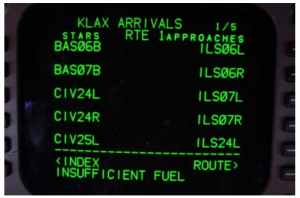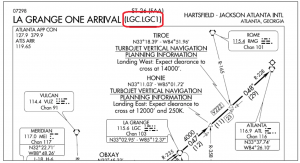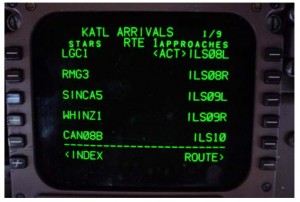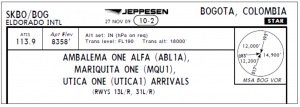51ST ANNUAL CONFERENCE, Kathmandu, Nepal, 12-16 March 2012WP No. 83Study SID and STAR Naming and Relevant FMS DesignPresented by TOC |
Summary
The use of SIDs and STARS has grown tremendously in the past decade. Unfortunately, there has been a noticeable lack of standardization and the result is pilots face a confusing mix of local practices. One of these is how the procedures are named.
This paper reviews the current situation, explores alternatives and proposes policy to encourage standardization.
Introduction
1.1 The use of SIDs and STARs has been growing rapidly over the past ten years and the pace continues to accelerate. In 2010, the goal of the FAA Performance-Based Navigation Office was the processing of 50 SIDs and STARs and 50 RNPs. In 2011, that goal grew to 214 SIDs and STARs and 133 RNPs.
1.2 Unfortunately, it has been difficult to manage this growth at the global level. The ongoing phraseology conflict concerning the cancellation of vertical guidance is well documented by IFATCA, ICAO and others. Some use the simple climb clearance to cancel the vertical restrictions of a SID, while others use it to mean the pilot is to fly the profile. The difference reflects a major safety risk.
1.3 But there are other aspects of SID and STAR development that introduce confusion. In some cases a procedure is copied, altered, and then given a name that differs from the original by only a single character, and this opens the door to a pilot error during a critical phase of flight.
1.4 SID and STAR naming is complicated by the FMS limitations. Many FMS only accept a six character SID name. Many therefore require an FMS “alias” or “identifier” that is used to type the procedure into the FMS. This is another potential source of confusion.
1.5 The issue of SID and STAR naming and identifiers was discussed in two TOC papers at the 2011 IFATCA Conference in Amman, WP 90 “SID and STAR Design” and WP 93 “Flight Management Systems”. WP90 recommended this topic for further study.
Discussion
2.1 Problem Definition and Experiences
2.1.1 In January 2008, Eurocontrol revealed a growing problem with confusion over the SID assignment, specifically at Schiphol Airport in Amsterdam. Schiphol reported a steady number of cases were observed where flight crews execute different SIDs from the one given to them by ATC and acknowledged by the crew.
“We even had cases where the correct SID was provided to the crew by data link and where the correct SID was mentioned again by the TWR controller when clearing the aircraft for takeoff, after which the crew read back the correct SID with the takeoff clearance, and still they flew a different (and incorrect) SID when airborne.”
“For one particular set of SIDs (from one particular runway) that often seems to be interchanged at Schiphol Airport, a trial was held by one of the major operators at the airport in which the mentioning of a specific SID in the ready made flight plan was replaced by the words ‘check SID’. This trial was considered a success, for after this modification there have been zero cases with this airline where the particular mistake occurred. Other airlines sometimes deviate from cleared SID.”
2.1.2 Because of confusion with departure procedures, on June 1, 2009, US airports KATL and KDFW began RNAV SID “Off The Runway” operations with new takeoff clearance phraseology below. The phraseology is meant to provide a final crosscheck to ensure that the programmed FMC path matches ATC’s expectations. Crews are expected to verify the first named fix in the FMC matches the takeoff clearance prior to departure. The clearance provides pilots with the RNAV indicator and also clarifies the first fix on the procedure, thus insuring that the first turn would be correct:
Delta 123, RNAV to FUTBL, Runway 27R, cleared for takeoff.
The bulletin put out by IFALPA to advise pilots of this new method said:
“As more airports develop RNAV SIDs, a lack of standardised ATC phraseology is causing confusion for pilots and ATC. The FAA, ALPA and operators have jointly developed new standardized takeoff phraseology and procedures for both pilots and controllers.”
2.1.3 When RNAV SIDs and STARs were introduced at Dublin in 2009, there were 20 instances of aircraft flying the incorrect SID. The SUROX4A turns left or right at 750 feet while SUROX4B does not. Pilots assigned the SUROX4B were occasionally flying the 4A and turning directly into preceding non-jet departures. As a result, Dublin instituted a procedure requiring pilots to readback the first fix on the assigned procedure. This relieved most of the errors. They considered the FAA solution above, but felt it was too late for the pilot to then execute a SID change.
2.1.4 Typically, SID and STAR names begin either with the identifier of the NDB or VOR they overfly or with the five letter name of a fix. This is followed by alphanumeric code (e.g. DONAD 1A). Some FMS systems only accept a 5-letter name plus an alphanumeric code. If the procedure is named for a fix and exceeds 6 characters, its identifier in the FMS will be different from that on the chart. Meanwhile, the ATM system may store the same procedure according to a different identifier so that the textual, character-by-character route displayed to the controller is not the same as that displayed to the pilot.
2.1.5 As the number of terminal procedures continues to skyrocket, and as most of these new procedures are complex, the risk increases.
2.1.6 That ANSPs are developing their own phraseology to issue clearances is of course a sign that action is needed at the global level. While this is not within the scope of this paper, it’s certainly an issue worthy of review.
2.2 AAL965 Accident
2.2.1 On December 20, 1995, American 965, a B757, crashed into terrain approaching Cali, Columbia. The aircraft had flown off course because one of the pilots had made an incorrect entry into the FMS. The pilot had been attempting to select ROZO, a waypoint on the arrival, but instead selected ROMEO, a beacon near Bogota.
2.2.2 The navigational data in the database was entered per the ARINC 424 Standard. This requires specific, unique identifiers for each item within each country, so that the combination of ICAO country code and identifier is unique worldwide. The Columbian government had assigned the letter “R” to both the fix ROZO and ROMEO. When the database was loaded, the letter “R” was entered for ROMEO because Bogota is a larger, more important city than Cali. The database refused to allow “R” for ROZO since it was already being used, so the identifier entered was the full name, ROZO. The pilot saw “R” on the chart and was unaware the database did not recognize it as ROZO.
2.2.3 A study of the accident produced the following conclusions:
“The evidence indicates that either the captain or the first officer selected and executed a direct course to the identifier “R,” in the mistaken belief that R was Rozo as it was identified on the approach chart. The pilots could not know without verification with the EHSI display or considerable calculation that instead of selecting Rozo, they had selected the Rome beacon, located near Bogota, some 132 miles east-northeast of Cali. Both beacons had the same radio frequency, 274 kilohertz, and had the same identifier “R” provided in Morse code on that frequency. In executing a turn toward Romeo rather than Rozo, the flightcrew had the airplane turn away from Cali and towards mountainous terrain to the east of the approach course, while the descent continued.”
2.2.4 The identifier “R” was shown on the charts for ROZO, but the FMS database required the pilot to enter full name ROZO, because “R” was reserved for ROMEO. The pilot entered the letter “R”, assuming that the database would list ROZO. The pilot may have observed the FMS display and not noticed the difference between ROZO and ROMEO.
2.2.5 The use of abbreviated identifiers in today’s FMS for SIDs and STARs offers the same opportunity for failure. Even if the controller spells out phonetically the assigned procedure, the pilot may need to enter in a different series of characters into the FMS. The procedure as shown in the FMS display can also be different than that shown on the charts. There is a distinct lack of harmony between these elements that can easily cause an error during critical phases of flight.
2.2.6 Datalink is the ultimate solution to there issues, since it will force absolute agreement between the FMS and the ATM system and will communicate with greater precision.

2.3 FMS Specific Performance
2.3.1 All FMS displays are character limited. The typical character limitation for procedure names on Boeing and Airbus equipment is six. Some systems can accept seven characters or more, while a few older units may be limited to five.
2.3.2 As example, at KLAX the CIVET arrival, which is runway dependent, has six characters. It is entered into the typical FMS as “CIV” followed by the three designators for the runway, such as “24R”, yielding a final pilot menu selection option of CIV24R.
2.3.3 The screenshot of an FMS display shows how these procedures are displayed to the pilot on a typical modern FMS.
2.3.4 Both Jeppesen and the U.S. Government Charts (FAA AeroNav Products, formerly known as NACO or NOAA) have developed a shorthand acronym for each procedure, when more than 6 characters. This acronym enables the pilot to decipher the named SID or STAR from what it is called on the chart and assigned by the controller from how it is depicted on the FMS. For example, the LA GRANGE ONE arrival into Atlanta clearly has more than six characters. However, the acronym for this procedure is shown in parentheses next to the full name on the chart and is LGC1, as shown in the chart and FMS display. Thus, the chart with the added information enables the pilot to decipher which SID/STAR acronym is used to store the procedure.

2.3.5 The Honeywell FMS then shows the LA GRANGE ONE as shown in the first option at the top right:

2.3.6 The FMS acronym is typically intuitive, but not always. In the below header from the Bogota arrival chart, one arrival is obvious (UTICA) but the others are more difficult to recognize or correlate with their full name. Note that if it was necessary to insert the runway name into the identifier, the version number and/or the route indicator would have to be dropped.
2.3.7 In some cases, the first five letters of two SIDs or STARs are identical, such as PINESTRAW SIX and PINESTAND EIGHT. Since the first 5 letters are identical and since the FMS is character limited these two procedures would require different abbreviations on the chart and in the FMS. The procedure could not simply be truncated to the PINES6 and PINES8 because the identifier would no longer be unique. As discussed, this was the case with ROZO and ROMEO in the Cali accident, since the Columbian government assigned both fixes the identifier “R”.

2.4 FMS Requirements
2.4.1 Two corporations are closely involved with the development of standards related to FMS and avionics system performance.
2.4.2 RTCA, Inc. is a private, not-for-profit corporation that develops consensus-based recommendations regarding communications, navigation, surveillance, and air traffic management (CNS/ATM) system issues. Originally the Radio Technical Commission for Aeronautics, RTCA today includes 400 government, industry and academic organizations from the United States and around the world, including Airservices Australia, Airbus, the Chinese Aeronautical Radio Electronics Research Institute (CARERI), ALPA, ARINC Incorporated, EUROCONTROL, MIT Lincoln Laboratory, the United States FAA, Thales Avionics Limited, the United Kingdom CAA, the Boeing Company, Garmin International, Rockwell International and many more.
2.4.3 RTCA DO-260B addresses performance standards for ADS-B transponders but does not discuss the use of SID and STAR identifiers.
2.4.4 ARINC Incorporated is provides communications, engineering, and integration solutions, and helps customers in the defense, commercial, and government industries mitigate risk, improve operational and systems performance, and meet program requirements. ARINC is a portfolio company of The Carlyle Group.
2.4.5 ARINC 424 contains five pages of guidance as to how a procedure name should be abbreviated. The information is very specific. This document is accepted as the governing authority that insures the integrity of the system as far as how procedures are identified accurately within a modern FMS.
Here is a short selection:
When source documents for procedure identifiers published by the controlling agency include computer abbreviations, they will be used in the appropriate fields. When the source provide codes designations are not compatible with the requirements of an aeronautical database, modifications are required. In such cases, SID/STAR identifiers are assigned to all procedures in accordance with the ground rules set forth in this Chapter. The SID/STAR identifier must be limited to a maximum of 6 characters in length. Current international standards for assigning coded designators permit up to 7 characters (ICAO Annex 11, Appendix 3). These seven characters normally consist of a basic indicator, validity indicator, and, when required, a route indicator. The basic indicator names the significant point where the departure terminates or the arrival begins. The ICAO validity indicator publicizes the current edition of the arrival or departure. This is a numeric character from one to nine. The ICAO route indicator is an alpha character which is added, as necessary, to distinguish between more than one departure terminating at the same significant point or arrival beginning at the same point.
By adhering to this guidance, FMS manufacturers, ANSPs and aircraft operators seem to have self-regulated and do not seem to have needed the involvement of ICAO in this process. The design of FMS boxes is highly technical and the mechanism of insuring the integrity of data entry is obviously an area of great importance to all parties in the aviation community. ARINC has performed a vital service by codifying this standard.
2.4.6 ICAO Doc 9681, the PBN Manual, refers to the RTCA document:
3.3.6.1 The navigation database should be obtained from a supplier that complies with RTCA DO 200A/EUROCAE document ED 76, Standards for Processing Aeronautical Data and should be compatible with the intended function of the equipment (Annex 6, Part 1, Chapter 7). A Letter of Acceptance (LOA), issued by the appropriate regulatory authority to each of the participants in the data chain, demonstrates compliance with this requirement (e.g. FAA LOA issued in accordance with FAA AC 20-153 or EASA LOA issued in accordance with EASA IR 21 subpart G).
2.5 FAA Requirements
2.5.1 From Appendix A of FAA 8260.46D:
5. g. Graphic ODPs and SIDs. Computer identification codes are assigned to graphic DPs by using the abbreviated name of the DP; e.g., a NAVAID or airport 3-letter NAVAID or airport identifier, a 4-letter geographical abbreviation, or a 5-letter fix/waypoint name, or other 5-letter code, followed by the current DP number, then a dot, followed by the fix/NAVAID identifier where the DP ends. For example, the CINCINNATI EIGHT DEPARTURE in appendix A, paragraph 2b is coded “CVG8.CVG;” the FORT LAUDERDALE SEVEN DEPARTURE in appendix A, paragraph 3 is coded “FLL7.FLL;” and the “TATES TWO DEPARTURE in appendix A, paragraph 2d is coded “TATES2.TATES.” A computer identification code is not required for radar vector SIDs that do not contain a specified or common route published as part of the SID; i.e., a SID based solely on radar vectors to the en route structure.
5. c. SID Transition. SID transition computer codes are assigned by using the SID identifier and number as noted in appendix A, paragraph 4b, followed by a dot, followed by the identifier of the en route fix where the transition ends. Using the Fort Lauderdale example in appendix A, paragraph 3, the ZAPPA transition is coded “FLL7.ZAPPA.” Using the REDSS example in appendix A, paragraph 3, the Johnstown transition is coded “REDSS4.JST.
2.5.2 The FAA requirements for creating computer identification codes for CDO and SID is fairly consistent with ARINC 424 and results in a six-character (or less) designator which is handled by most FMS.
2.6 ICAO Documentation
2.6.1 ICAO has a lot of guidance material about Standard Instrument Departure Routes and Standard Instrument Arrival Routes. The concept of SIDs and STARs is laid down in Annex 11 3.7.1.2., which in turn makes reference to PANS-OPS Doc. 8168 Volume I “Flight Procedures” (aimed at Aircraft Operators) and Volume II “Construction of Visual and Instrument Flight Procedures” (aimed at procedure designers) as well as to the Air Traffic Services Planning Manual Doc 9426.
2.6.2 The following definitions are from PANS-OPS Volume I and II:
Standard instrument arrival (STAR): A designated instrument flight rule (IFR) arrival route linking a significant point, normally on an ATS route, with a point from which a published instrument approach procedure can be commenced.
Standard instrument departure (SID): A designated instrument flight rule (IFR) departure route linking the aerodrome or a specified runway of the aerodrome with a specified significant point, normally on a designated ATS route, at which the en-route phase of a flight commences.
2.6.3 The following designator guidance is from Annex 11, Appendix 3:
1.1 The system of designators shall:
a) Permit the identification of each route in a simple and unambiguous manner;
b) Make a clear distinction between:
— Departure routes and arrival routes;
— Departure or arrival routes and other ATS routes;
— Routes requiring navigation by visual reference to ground-based radio aids or self-contained airborne aids, and routes requiring navigation by visual reference to the ground;
c) Be compatible with ATS and aircraft data processing and display requirements;
d) Be of utmost brevity in its operational application;
e) Avoid redundancy;
f) Provide sufficient possibility for extension to cater for any future requirements without the need for fundamental changes.
2.1 Plain language designator
2.1.1 The plain language designator of a standard departure or arrival route shall consist of:
a) A basic indicator; followed by
b) A validity indicator; followed by
c) A route indicator, where required; followed by
d) The word “departure” or “arrival”; followed by
e) The word “visual”, if the route has been established for use by aircraft operating in accordance with the visual flight rules (VFR).
2.1.2 The basic indicator shall be the name or name-code of the significant point where a standard departure route terminates or a standard arrival route begins.
2.1.3 The validity indicator shall be a number from 1 to 9.
2.1.4 The route indicator shall be one letter of the alphabet. The letters “I” and “O” shall not be used.
2.2 Coded designator
The coded designator of a standard departure or arrival route, instrument or visual shall consist of:
a) The coded designator or name-code of the significant point described in 21.1 a); followed by
b) The validity indicator in 2.1.1 b); followed by c) The route indicator in 2.1.1 c), where required.
Note. – Limitations in the display equipment on board aircraft may require shortening of the basic indicator, if that indicator is a five-letter name-code, e.g. KODAP. The manner in which such an indicator is shortened is left to the discretion of operators.
2.6.4 There are a number of important elements of these requirements. Note that there are guidelines for both the plain language designator and a coded designator. But ICAO has left the construction of the designator to the “operators”.
2.6.5 ICAO PANS-OPS Doc 8168 Volume II refers specifically to the ARINC document:
Chapter 5 NAVIGATION DATABASE CODING
5.1 GENERAL
5.1.1 The purpose of this chapter is to provide guidance to procedure designers concerning elements in procedure design that will facilitate the coding of procedures into navigation databases.
5.1.2 All navigation data used by an RNAV system that is certified for terminal operations are held in a navigation database. These databases are derived from data that is coded in accordance with the aviation industry standard: ARINC 424 ‘Navigation System Database Specification’, or an equivalent industry standard.
2.6.6 By referencing ARINC 424 in Doc 8168, ICAO is essentially requiring all FMS databases to conform with these specifications. All FMS databases should therefore be in compliance.
2.7 IFALPA
2.7.1 IFALPA’s POL-STAT 1981 expressed a strong desire to see more runways included in a single procedure so that the assignment of a procedure doesn’t change when the runway changes.
2.7.2 The POL-STAT also states that a direction indicator should be included in the designator. This is referred to in Annex 3 as a “route indicator”. In Frankfurt, a character is appended to all STARs to indicate whether the transition runs north or south of the field.
2.7.3 The POL-STAT also states that the designator should somehow identify RNAV SIDs and STARs. To a pilot, flying an RNAV departure involves different way of navigating and possibly making changes to the RNP value in the FMS. It’s important to the pilot to know the procedure is RNAV.
2.7.4 The issue of multiple procedures coming from the same runway is complicated. Generally, fewer procedures is better because more charts means more complexity. However, if the charts themselves become too busy that is also a risk.
Conclusions
3.1 The production of SIDs and STARs is increasing globally. RNAV procedures are enabling more efficient use of airspace and ANSPs are therefore eager to implement them.
3.2 As more of these procedures have been implemented, it has become more difficult for pilots to insure they have set their FMS with the correct procedure. Some reasons for this include:
- Large number of procedures.
- Lack of standardization on naming conventions, where the correlation between what is entered into the FMS with the procedure issued is not always intuitive.
- The ease with which the pilot can set the FMS.
- The complexity of the procedures.
3.3 The lack of standardization between FMS databases and aeronautical data produced by States can lead to major accidents.
3.4 FMS limitations, specifically the abbreviations used to enter the procedure into the FMS, are a major factor in pilots flying the wrong procedure.
3.5 ARINC 424 contains strict methods for abbreviating SIDs and STARs for use in flight management systems. These methods are comprehensive and provide for system integrity. ICAO has embraced this standard in Doc 8168 Volume II.
3.6 Some States are creating new phraseology to clarify the routing, including reconfirming the procedure to be flown, indicating the first fix or turn direction and indicating whether the procedure is RNAV or not. This suggests the need for a global solution.
3.7 IFALPA has expressed a desire for the following:
- Direction indicator in the procedure name
- RNAV indicator in the procedure name
- Reduced number of distinct procedures for each runway.
3.8 ICAO Annex 11 has guidance on how SIDs and STARs should be named. However, these guidelines have led to different ways of implementation that have led to confusion.
3.9 IFATCA Policy on FMS is relevant to SID and STAR naming. The FMS should be able to accommodate ATM requirements.
Recommendations
It is recommended that;
4.1 IFATCA policy is:
SID and STAR designators should be identical between the ATM system and the FMS.
And is included in the IFATCA Technical and Professional Manual.
References
IFATCA 2010 Conference, WP 88, “Investigate Operational Use of Level Restrictions in SIDs, STARs and other Published Routes”, Punta Cana, 12-16 April 2010.
ICAO State Letter AN 13/2.1-10/12, Subject: SID/STAR level revisions, 17 February 2010.
IFATCA 2011 Conference, WP 90, “ATS – Study SID and STAR Design”, Amman, 11-15 April 2011.
IFATCA 2011 Conference, WP 93, “Study the Operation of Aircraft Flight Management Systems”, Amman, 11-15 April 2011.
Eurocontrol Safety Report, January 22, 2008.
AA965 Cali Accident Report, Peter Ladkin Universität, Bielefeld Germany, November 6, 1996.


